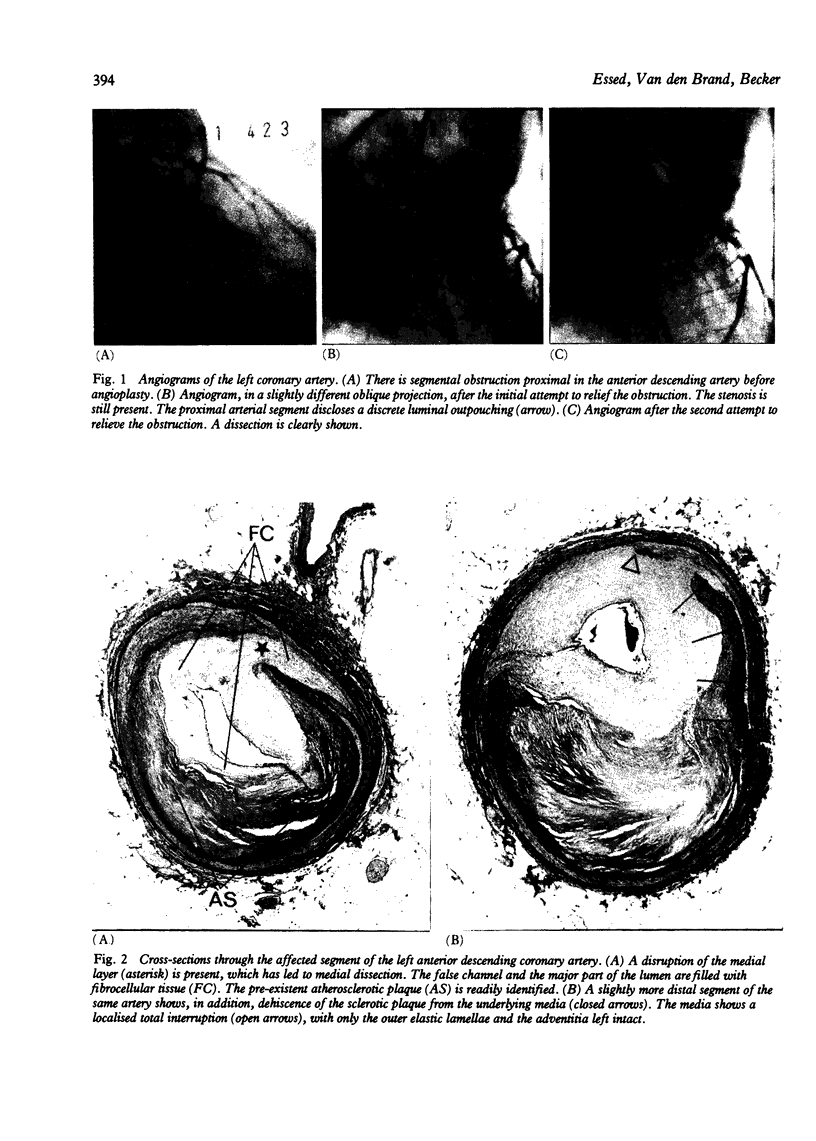Abstract
Transluminal coronary angioplasty was performed in a 51 year old man with a localised narrowing of the proximal segment of the left anterior descending coronary artery. Initial inflations with a small size balloon catheter were unsuccessful. A second attempt, during the same procedure, using a larger calibre catheter relieved the obstruction but produced a dissection. Angina pectoris reappeared approximately three months later. Another attempt to relieve the obstruction by angioplasty, five months after the initial procedure, induced ST segment elevation before angioplasty, followed by ventricular fibrillation and death. The necropsy showed a split in the pre-existent sclerotic plaque and a dissecting aneurysm of the media. A proliferation of fibrocellular tissue filled the false channel and almost totally occluded the pre-existent arterial lumen. The observation suggests that wall laceration with exposure of smooth muscle cells to blood may have initiated the excessive fibrocellular tissue response. This event may be the underlying pathogenetic mechanism for the occurrence of early restenosis after transluminal coronary angioplasty.
Full text
PDF



Images in this article
Selected References
These references are in PubMed. This may not be the complete list of references from this article.
- Baughman K. L., Pasternak R. C., Fallon J. T., Block P. C. Transluminal coronary angioplasty of postmortem human hearts. Am J Cardiol. 1981 Dec;48(6):1044–1047. doi: 10.1016/0002-9149(81)90318-0. [DOI] [PubMed] [Google Scholar]
- Block P. C., Baughman K. L., Pasternak R. C., Fallon J. T. Transluminal angioplasty: correlation of morphologic and angiographic findings in an experimental model. Circulation. 1980 Apr;61(4):778–785. doi: 10.1161/01.cir.61.4.778. [DOI] [PubMed] [Google Scholar]
- Block P. C., Fallon J. T., Elmer D. Experimental angioplasty: lessons from the laboratory. AJR Am J Roentgenol. 1980 Nov;135(5):907–912. doi: 10.2214/ajr.135.5.907. [DOI] [PubMed] [Google Scholar]
- Block P. C., Myler R. K., Stertzer S., Fallon J. T. Morphology after transluminal angioplasty in human beings. N Engl J Med. 1981 Aug 13;305(7):382–385. doi: 10.1056/NEJM198108133050706. [DOI] [PubMed] [Google Scholar]
- Grüntzig A. Die perkutane Rekanalisation chronischer arterieller Verschlüsse (Dotter-Prinzip) mit einem neuen doppellumigen Dilatationskatheter. Rofo. 1976 Jan;124(1):80–86. doi: 10.1055/s-0029-1230286. [DOI] [PubMed] [Google Scholar]
- Kent K. M., Bentivoglio L. G., Block P. C., Cowley M. J., Dorros G., Gosselin A. J., Gruntzig A., Myler R. K., Simpson J., Stertzer S. H. Percutaneous transluminal coronary angioplasty: report from the Registry of the National Heart, Lung, and Blood Institute. Am J Cardiol. 1982 Jun;49(8):2011–2020. doi: 10.1016/0002-9149(82)90223-5. [DOI] [PubMed] [Google Scholar]
- Lee G., Ikeda R. M., Joye J. A., Bogren H. G., DeMaria A. N., Mason D. T. Evaluation of transluminal angioplasty of chronic coronary artery stenosis. Value and limitations assessed in fresh human cadaver hearts. Circulation. 1980 Jan;61(1):77–83. doi: 10.1161/01.cir.61.1.77. [DOI] [PubMed] [Google Scholar]
- Pasternak R. C., Baughman K. L., Fallon J. T., Block P. C. Scanning electron microscopy after coronary transluminal angioplasty of normal canine coronary arteries. Am J Cardiol. 1980 Mar;45(3):591–598. doi: 10.1016/s0002-9149(80)80009-9. [DOI] [PubMed] [Google Scholar]
- Ross R., Glomset J. A. The pathogenesis of atherosclerosis (first of two parts). N Engl J Med. 1976 Aug 12;295(7):369–377. doi: 10.1056/NEJM197608122950707. [DOI] [PubMed] [Google Scholar]
- Rutherford R. B., Ross R. Platelet factors stimulate fibroblasts and smooth muscle cells quiescent in plasma serum to proliferate. J Cell Biol. 1976 Apr;69(1):196–203. doi: 10.1083/jcb.69.1.196. [DOI] [PMC free article] [PubMed] [Google Scholar]




